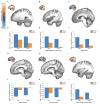Anxiety Patients Show Reduced Working Memory Related dlPFC Activation During Safety and Threat
- PMID: 27110997
- PMCID: PMC5079837
- DOI: 10.1002/da.22518
Anxiety Patients Show Reduced Working Memory Related dlPFC Activation During Safety and Threat
Abstract
Background: Anxiety patients exhibit deficits in cognitive tasks that require prefrontal control of attention, including those that tap working memory (WM). However, it is unclear whether these deficits reflect threat-related processes or symptoms of the disorder. Here, we distinguish between these hypotheses by determining the effect of shock threat versus safety on the neural substrates of WM performance in anxiety patients and healthy controls.
Methods: Patients, diagnosed with generalized and/or social anxiety disorder, and controls performed blocks of an N-back WM task during periods of safety and threat of shock. We recorded blood-oxygen-level dependent (BOLD) activity during the task, and investigated the effect of clinical anxiety (patients vs. controls) and threat on WM load-related BOLD activation.
Results: Behaviorally, patients showed an overall impairment in both accuracy and reaction time compared to controls, independent of threat. At the neural level, patients showed less WM load-related activation in the dorsolateral prefrontal cortex, a region critical for cognitive control. In addition, patients showed less WM load-related deactivation in the ventromedial prefrontal cortex and posterior cingulate cortex, which are regions of the default mode network. Most importantly, these effects were not modulated by threat.
Conclusions: This work suggests that the cognitive deficits seen in anxiety patients may represent a key component of clinical anxiety, rather than a consequence of threat.
Trial registration: ClinicalTrials.gov NCT00047853.
Keywords: GAD/generalized anxiety disorder; anxiety/anxiety disorders; cognition; functional MRI; stress.
© 2016 Wiley Periodicals, Inc.
Conflict of interest statement
The authors report no conflicts of interest.
Figures





Similar articles
-
Patients with anxiety disorders rely on bilateral dlPFC activation during verbal working memory.Soc Cogn Affect Neurosci. 2020 Dec 24;15(12):1288-1298. doi: 10.1093/scan/nsaa146. Soc Cogn Affect Neurosci. 2020. PMID: 33150947 Free PMC article.
-
Working memory dysfunction associated with brain functional deficits and cellular metabolic changes in patients with generalized anxiety disorder.Psychiatry Res Neuroimaging. 2016 Aug 30;254:137-44. doi: 10.1016/j.pscychresns.2016.06.013. Epub 2016 Jun 25. Psychiatry Res Neuroimaging. 2016. PMID: 27442922
-
Functional neuroanatomy on the working memory under emotional distraction in patients with generalized anxiety disorder.Psychiatry Clin Neurosci. 2015 Oct;69(10):609-19. doi: 10.1111/pcn.12295. Epub 2015 Apr 21. Psychiatry Clin Neurosci. 2015. PMID: 25781332
-
Specifically altered brain responses to threat in generalized anxiety disorder relative to social anxiety disorder and panic disorder.Neuroimage Clin. 2016 Oct 5;12:698-706. doi: 10.1016/j.nicl.2016.09.023. eCollection 2016. Neuroimage Clin. 2016. PMID: 27761400 Free PMC article.
-
Vive les differences! Individual variation in neural mechanisms of executive control.Curr Opin Neurobiol. 2010 Apr;20(2):242-50. doi: 10.1016/j.conb.2010.03.002. Epub 2010 Apr 8. Curr Opin Neurobiol. 2010. PMID: 20381337 Free PMC article. Review.
Cited by
-
The bed nucleus of the stria terminalis and functionally linked neurocircuitry modulate emotion processing and HPA axis dysfunction in posttraumatic stress disorder.Neuroimage Clin. 2020;28:102442. doi: 10.1016/j.nicl.2020.102442. Epub 2020 Sep 24. Neuroimage Clin. 2020. PMID: 33070099 Free PMC article.
-
Relationships between depression, anxiety, and motivation in the real-world: Effects of physical activity and screentime.medRxiv [Preprint]. 2024 Aug 20:2024.08.06.24311477. doi: 10.1101/2024.08.06.24311477. medRxiv. 2024. PMID: 39148830 Free PMC article. Preprint.
-
Executive function and other cognitive deficits are distal risk factors of generalized anxiety disorder 9 years later.Psychol Med. 2018 Sep;48(12):2045-2053. doi: 10.1017/S0033291717003579. Epub 2017 Dec 11. Psychol Med. 2018. PMID: 29224581 Free PMC article.
-
Prefrontal Executive Control Rescues Risk for Anxiety Associated with High Threat and Low Reward Brain Function.Cereb Cortex. 2019 Jan 1;29(1):70-76. doi: 10.1093/cercor/bhx304. Cereb Cortex. 2019. PMID: 29161340 Free PMC article.
-
The ventromedial prefrontal cortex in response to threat omission is associated with subsequent explicit safety memory.Sci Rep. 2024 Mar 28;14(1):7378. doi: 10.1038/s41598-024-57432-0. Sci Rep. 2024. PMID: 38548770 Free PMC article.
References
-
- American Psychiatric Association. Diagnostic and Statistical Manual of Mental Disorders: Dsm-5. Arlington, VA: Amer Psychiatric Pub Incorporated; 2013.
-
- Eysenck MW, Derakshan N, Santos R, et al. Anxiety and cognitive performance: attentional control theory. Emotion. 2007;7:336–53. - PubMed
MeSH terms
Associated data
Grants and funding
LinkOut - more resources
Full Text Sources
Other Literature Sources
Medical
Miscellaneous

